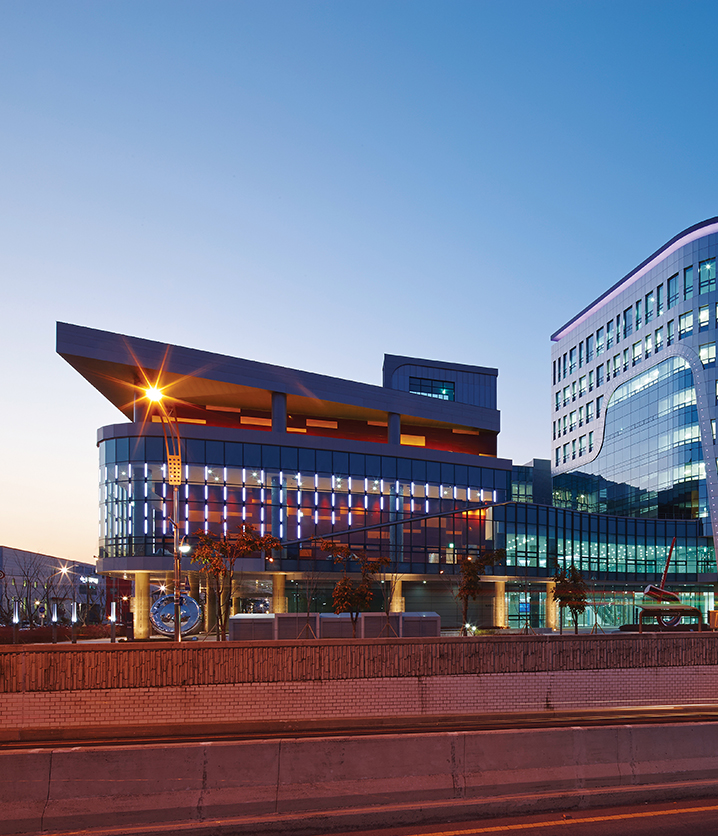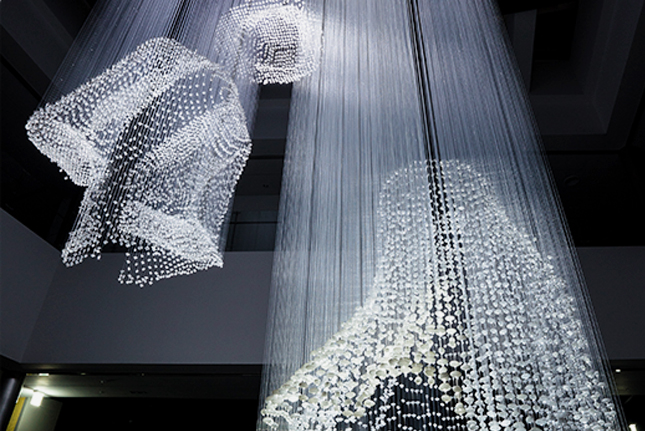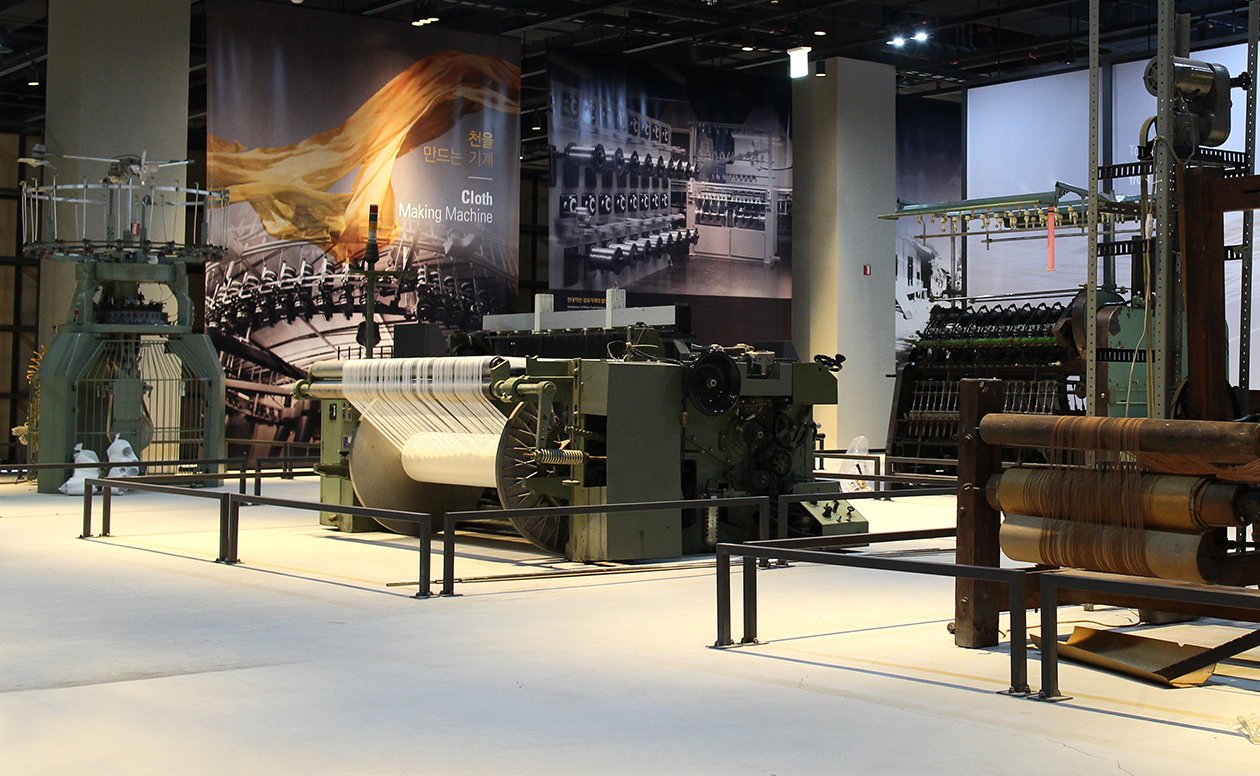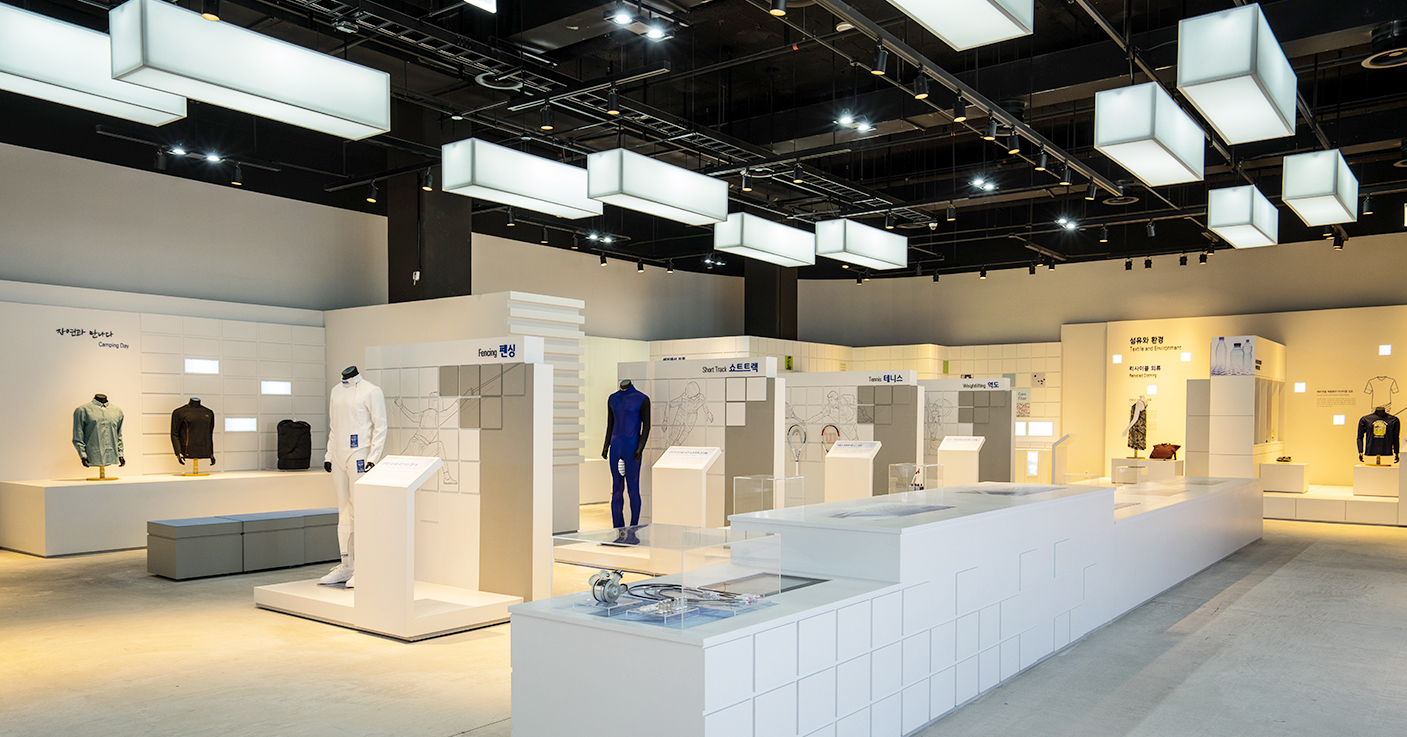VOL.58
January 2020


Trip — Daegu Textile Museum
A fascinating space
where you can appreciate the value and history of textile and clothing!
Daegu Textile Museum
Clothing, along with food and shelter, is an essential daily necessity for humans. Yet few people ever think about the true value of clothing or textiles even though they wear clothes every day. The Daegu Textile Museum was established to reflect this reality. It is a uniquely interesting place where visitors can appreciate the significance of clothing and textiles. Visitors to the museum can take a close look at past fashion trends, learn all about the ways in which the textile industry has enriched people’s lives, and experience up-to-date fabric products.

© Daegu Textile Museum

Movements in Stillness, on display in the lobby of the DTC Textile Museum.
Fashion Hall: Discover the history of fashion in Korea
Opened in May 2015, the DTC (Daegu Textile Complex) Textile Museum is popular as a venue where visitors can learn everything there is to know about textiles. Daegu, affectionately dubbed the “Milan of Asia”, is the representative city of Korea’s textile industry. The city embraces all the elements of the textile industry from yarn manufacturing and weaving, through dyeing, to distribution and trading. Indeed, it is rare to see such a city anywhere in the world. Furthermore, Daegu is home to the Seomun Market, the country’s largest marketplace for fabrics and its biggest textile industrial complex. It is only natural that the textile museum should be located in Daegu.
Visitors to the museum are welcomed by a gigantic artwork in the front yard, a dazzling combination of yellow, green and red threads and a huge needle pointing to the sky. Upon stepping into the first floor, visitors are met by the Hall of Fame, where the names of the donors of exhibits to the museum were inducted. The tour really gets going with the Fashion Hall on the second floor. Here, in the center of the lobby, is a mystical artwork that captivates both the eyes and hearts of visitors. The work, titled “Movements in Stillness”, is made of optical fibers, and consists of a transparent skirt, jacket and hat suspended from the ceiling by glittering threads.
In the Fashion Hall, visitors can explore the history of Korean fashion from the 1900s onwards. The exhibits include a mini skirt worn by the famous singer Yun Bok-hi, who stirred the whole nation in the 1960s, a mannequin dressed in bell-bottom pants that bring to mind the hit 1970s film Sunny, and popular hip-hop fashions of the 1990s that are likely to arouse lingering memories of the TV program We Are Singers on Saturday. Visitors to the Fashion Hall can also browse past fashion trends through the works of various designers and brands. One notable item is a 1951 dress with beaded decoration designed by Christian Dior, whose exquisite artistry and workmanship are comparable with those of a great artwork. Despite its classical design, the dress still looks so incredibly beautiful and contemporary almost seven decades after its making that it would fit a fashionable lady of today to perfection.

A view of the Fashion Industry Hall on the third floor.
Textile Industry Hall: Explore the vicissitudes and developments of the Korean textile industry
Visitors to the Textile Industry Hall on th4e third floor can take a closer look at the history of textiles, fabric materials, and machinery. The organizers took great care to make the hall original, creating a “cube room” and a “pocket theater.” Children can enjoy examining fabrics and textiles under the microscope, while adult visitors can learn about the historical facts of the textile industry. A legal document on a law governing the everyday life of ordinary citizens issued in 1951 ? a year in which the Korean War was raging ? listed the fabrics banned by the government, including foreign satin, velvet, habutae, lace and nylon.
Visitors will also discover how the local textile industry was hit by a new wave in the 1960s ? the advent of nylon fabric. Nylon has since become deeply embedded in Korean society, just as it has in many other countries. It might be interesting to learn that the custom whereby Koreans buy their parents red thermal underwear with their first paycheck derives from nylon. As dyeing technology for the new fabric was limited in the early years, much of the fabric was dyed in the easiest color, red. Nylon also gave birth to new coinages. Among the newly-coined words were “nylon socks,” “nylon college” and “nylon maiden,” all of which were derived from the fact that Korea Nylon Co., the company that produced nylon for the first time in the country in 1958, offered exceptionally good working conditions for its employees. For instance, it provided dormitories to workers, who were divided into three eight-hour work shifts each day. The term “nylon college” reflected people’s desire to get a college education, while “nylon maiden” represented young women’s aspiration to wear nylon clothes, and nylon socks represented long durability. As time went by, however, people were awakened to the defects of the fabric, including its low absorbency and air permeability. Ultimately, nylon became associated with fake, counterfeit or substandard.
Visitors to the Industry Hall will encounter the past and present major players of the Korean textile industry, including Korea Nylon Co., Kolon Industries and Cheil Industries, the latter being the parent company of what is now Samsung Group. The history of these companies shows that textiles were at the forefront of the social trends and enriched people’s lives. The textile industry was also a locomotive of the nation’s economic growth. Astonishingly, textile exports, which exceeded one billion US dollars, accounted for 47.3 percent of the country’s total exports in 1973. Textiles continued to flex their muscles in subsequent years, with exports topping 10 billion US dollars in 1987.

A view of the Textile Future Hall on the fourth floor.
Textile Future Hall: Experience the very latest textile products
After learning all about various textile products and their history on the third floor, visitors can experience the very latest textiles and fabrics, some of which are not yet available to ordinary citizens, in the hall on the fourth floor. Visitors can take a ride in a simulator car made of carbon fiber, or try on a firefighting suit made with a shape-memory alloy that can withstand temperatures as high as 4000 Celsius or a bullet-proof jacket made of a new material that’s five times stronger than steel. Also on display are various protective skin suits for short-track skaters, fencers and weightlifters. Visitors can touch the clothes of the future, including garment which respond to sound, human emotional changes, and exposure to light. Simply push a button and the clothes will light up themselves, while an equalizer will adjust the patterns and colors of the clothes in response to sounds.
The museum also runs a variety of public education programs. It recently launched a program for preschoolers sponsored by the Daegu Foundation for Culture. Launched in June 2019, the “Let’s Play Textiles!” program will run 80 classes for children from 20 kindergartens and nurseries in the city. In September, children participating in the “Kok Kok Kok Needle Play (Needle Punch)!” program learned about needles and tried their hand at embroidery using a unique needle named “needle punch.” In addition, from September to November of last year the Korean Museum Association sponsored the “Let’s Learn about Fashion City Daegu and Fashion Design” program on the last Wednesday and Saturday of each month. Admission to the Daegu Textile Museum and all of its education programs are completely free of charge, so there is no reason for anyone to miss out on a fun opportunity to learn all about the value of textiles



